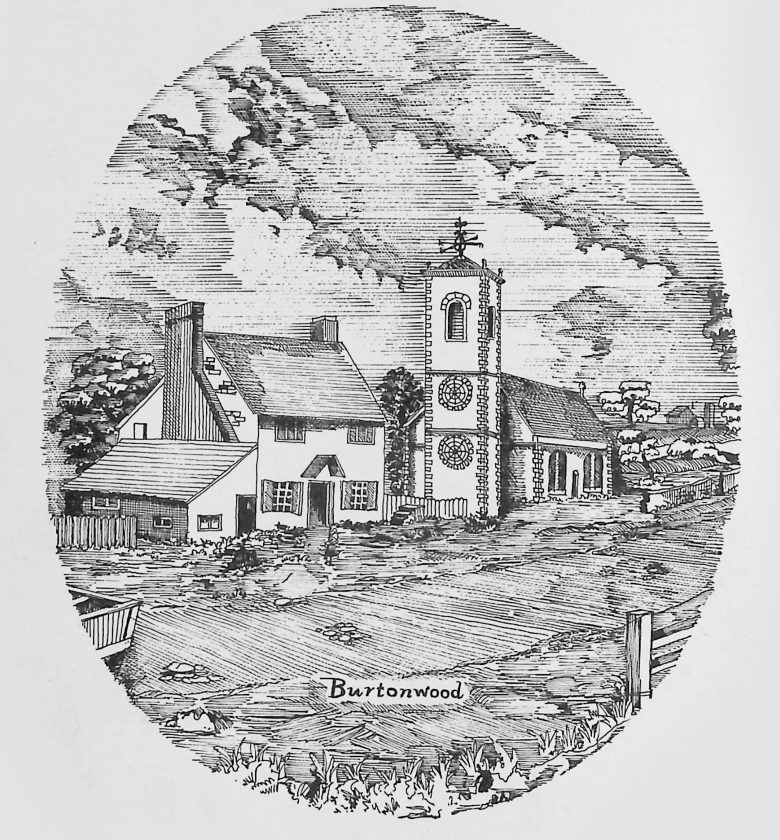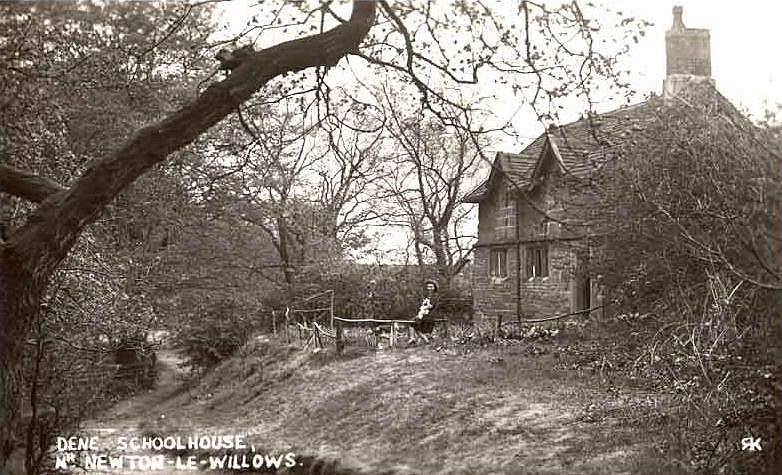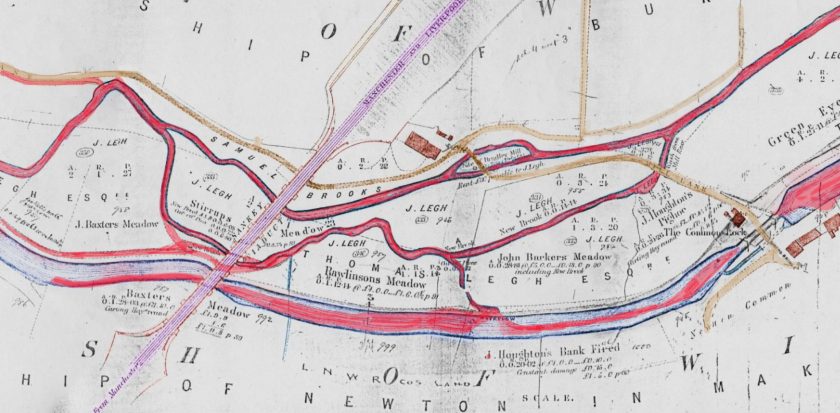The History of Newton Hall ,
Newton-le-Willows
Introduction
During the course of the research many details were found relating to Newton Hall in Newton-le-Willows (formerly Newton in Makerfield). These include not only the names of a number of the owners and occupiers but also a description of the interior of the property and some of the earlier history of the site.
It would appear that Newton Hall stands on the site of or at least very close to the site of another property, long gone. Built in 1634, the later property, which is sometimes referred to as the Mansion House, Manor House or Old Hall and later Boydell s Farm, was originally owned by Thomas Blackburn. During the 1650s it was sold to Sir Richard Fleetwood but by the early 1660s it was owned by the Legh family. They remained in possession until at least the early 1840s when the Boardman s were tenants. From then on it had a succession of occupants, but it is not certain if they were both owners and occupiers or just occupiers. Early in the 1900s the property was occupied by the Boydell s whose name was used when referring to the property.
A description of the property as it was in its early days paints a picture of a characteristic Carolean property with Elizabethan features. However, alterations were made during the latter half of the 19th century making the property, internally at least, more practical and comfortable for its purpose, a 19th century farmhouse.
It is a matter of opinion as to whether, or not these alterations enhanced the property, but by the 1960s it was derelict and was sadly demolished.
However, the documented historical details and descriptions of the property together with a number of surviving photographs and pictures combine to create a lasting image of this beautiful building.
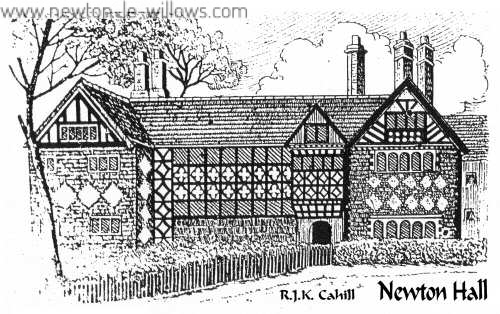
Sketch of Newton Hall, by R. J. K. Cahill
A number of the sources that were used during the course of the research contain much conflicting information and theories, particularly relating to Newton Hall s connection with the Manor of Newton. As a result of this, attempts have been made to understand why these contradictions occurred and to unravel the information contained in these accounts. What follows is an analysis of the history of Newton Hall derived from what has been considered the most logical interpretation of these often confusing sources.
Sources Used
Various sources were used during the course of the research and these were housed at the Lancashire County Records Office in Preston, St. Helen s Library and Local Studies Unit and he John Ryland s University Library in Manchester.
Legh of Lyme Muniments
These are the family and estate papers relating to the Legh family who owned land in Lancashire and Cheshire and were one time owners of Lyme Hall. The collection is extensive, but little relating to Newton Hall was found. Many of the rent books or lists of tenants do not mention actual properties by name, thus making it difficult to identify them. However, the documents that were found that did contain details relating to Newton Hall proved to be vital to the research, particularly the 1665 Indenture.
Tithe Maps
Tithe s were a percentage of all produce that had to be paid to the Church. Tithe records consist of a map and a journal. The map gives a number for each particular field and the journal lists the names of the owner and tenant of each of these fields.
Introduced during the reign of Charles II in 1662, properties were liable to a tax, depending upon the number of hearths. Unfortunately, these documents usually just mention the occupiers name, so this can make it difficult identifying a particular property..
Requisitioned Premises.
These records list all the properties in a particular town that were requisitioned for War use during the Second World War. The records give the name of the property, the date that it was requisitioned, its purpose, and which Government Department had requisitioned it.
Census Returns.
The Census has been taken every en years since 1801. However, until 1841, the records were merely a head count and are not much use for House History or Genealogy. The Returns give such details as the names of the people living at a given address, their ages, occupations, relationship with the head of the household, place of birth. The later Returns do contain more details than the earlier ones.
Directories
Directories are a forerunner of telephone directories. They give the names and addresses, and with the later ones, telephone numbers, of the businesses, and often private addresses, for each a particular town.
Royalist Composition Papers
During the English Civil War of 1642 — 1651 and the Interregnum, 1649-60, The Parliament sequestrated property, lands and sometimes possessions, belonging to known supporters of King Charles 1 and of Roman Catholics. Sequestrated property and land was either sold or the original owner could compound Compounding meant buying the property back This was often done, but the owner had to often sell some land or property in order to raise enough money to, buy his own land or property back Some of the sequestrated property was returned when the Monarchy was restored The source used during this research project was a published edition of the Composition Papers relating to Lancashire land and Property owners, extracted from the documents of the Committee for Compounding.
Newton Hall – The Early Days
There is evidence to suggest that prior to the building of Newton Hall another, much earlier property, occupied a position adjacent to its site. It is not clear when this earlier property was built. Reports conflict.
It is claimed by an Archaeological Report by Merseyside County Council, that this property was built during the 11th century by Robert Banastre. (l) It goes on to say that he came over with William the Conqueror. (2) As such, the early hall would have been built sometime during the late 11th century, after 1066. The Archaeological Report goes on to give a description of the first Newton Hall as having two wings and being surrounded by a moat. (3)
C. Cole in his history of Newton-in Makerfield, gives a differing account. He claims that Robert Banastre built the first Newton Hall but that he was living circa 1250-1292, some 200 years after the Conquests. (4) Clearly, this could not be the same Robert Banastre who came over with the Conqueror, but he could be a descendant. This theory is backed up little by Lane. He cites that the Fee of Makerfield was given to Roger de Poictu in 1066 who in turn gave the fee to Robert Banastre. (5) On his death, the fee passed to his son, another Robert, and then successively through generations. However, if he did build the first hall it therefore dated from the latter half of the 13th century and not the 11th. Either both Cole and Lane or the Archaeological report is wrong in this.
(1) Archaeological Report. Newton-le-Willows Hall, Newton Mill and Water Mill, Merseyside County Council, 1988. (Henceforth MCC Arch. Rep.)
(2) MCC Arch. Rep.
(3) Ibid
(4) Cole C., A History of Newton-in-Makerfield, p.177. (henceforth `Cole, Newton)
Regardless of which source is correct, there is other evidence that shows that there was an earlier property close to the site of the later hall.
In 1293 the Fee of Makerfield passed through marriage from Alice Banastre to John Langton. (6) Over 50 years later in 1341 Robert de Langton was granted a license to crenellate his mansion (7)
It would seem that the 11th / 13th century Hall and Langtons crenellated mansion were the same property. Philpott cites two sources which point to both the former hall existing and it being one and the same with Langtons Mansion. His first source is the Legh Survey dating from 1465. (8)
Philpott says;
"The Legh Survey of 1465 refers to a piece of land called Le Pyke in Chesterside which lay to the east of another field, Laghrfelde, which led to the Hall of Newton. The document is slightly obscure at this point but it indicates that the Hall at this period lay south of, but not far from, the High Street." (9)
(5) Riley, Peter (Ed), Lane, J. H. A History of Newton in Makerfield, 1992, pp. 7/8. (Henceforth Riley, Newton in Makerfield). A Fee was a gift of land given as a reward to all those who helped the Norman Conquest.
(6) Ibid, p.8
(7) MCC. Arch. Rep. and Philpott, R A. Historic Towns of the Merseyside Area; National Museums and Galleries of Merseyside Occasional Papers, Liverpool Museum, p.18 (henceforth Philpott, Historic Towns)
(8) The Leghs owned much land and property in Newton and were at one time the Lords of the Manor.
(9) Philpott, Historic Towns, p.16
He then goes on to quote Dr. Kuerden. Kuerden was a local antiquary and he visited the Parish of Winwick around 1695. Dr. Kuerden;
..crossed the little stone bridge over Newton Brook, three miles from Warrington. On the left hand side close by a water mill appear the ruins of the site of the ancient barony of Newton, where formerly was the baron s castle." (10)
(10) Ibid, p.16
As Philpott says, this description clearly puts the ruins that Kuerden saw near the site of the later, 17th century hall because of his references to the brook and the mill. Also, the fact that he refers to it as the `barons castle no doubt refers to the crenellations that were added to Robert de Langton s mansion, thus the 11th / 13th century property and Robert de Langtons mansion appear to be one and the same.
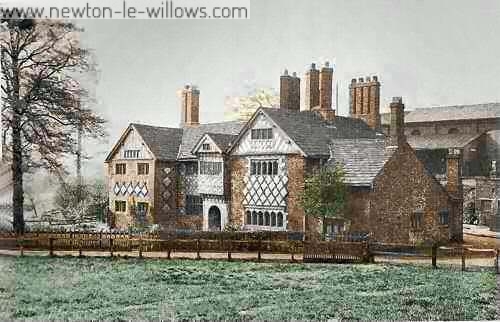
Newton Hall Viewed from Newton Bridge side
It is not known when this early hall fell into disuse or why, but it was some time after 1465. Dr. Kuerden shows that it must have fallen into disrepair sometime before his visit in 1695 as he describes it as ruins. It is most likely that the hall that Richard Blackburn built in 1634 replaced the old building. Therefore the original hall must have ceased to be inhabited prior to this date. No evidence has been found relating to another inhabited property close to the 17th century hall that could be the earlier hall so it must be concluded that it was abandoned during the early 17th century or before.
Richard Blackburns Hall.
The Blackburns originally came from Yorkshire. Two brothers, Richard and William settled in Newton after acquiring lands there in 1586. (11) Richard died without marrying and it was Williams eldest son, Richard who built Newton Hall. (12) Richard appears to have given much support to the local community, particularly the church. He is recorded as giving f200 to Newton chapel to help support a Preaching Minister. (13)
(11) Cole, Newton, p176.
(12) Ibid p.176
(13) Ibid p.176.
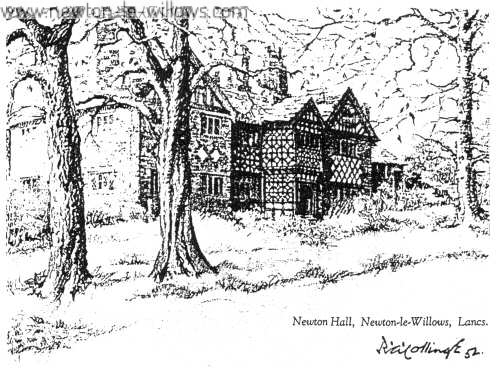
Sketch of Newton Hall by R A. Collings
Richard Blackburn built Newton Hall in 1634. (14) The Merseyside County Council Archaeological report, again shows some inconsistency with other sources regarding the building of the Hall. Although it agrees with the other sources as regards the date that it was built, it says that Thomas, not Richard Blackburn, built the hall. Also it says that it was built during the reign of Queen Elizabeth. Queen Elizabeth I died in 1603, 31 years before. It was King Charles I who was on the throne when Newton Hall was built.
There is no doubt that the hall was built circa 1634. Extracts from a contemporary diary, dated 13th October 1634 to 12th October 1635, give evidence of this. (15)
"Oct. the 13th 1634 — About bildinge I did spend the whole of this day Reasonably well spent I this day in sivell outward cariage, but inwardly I am worldly miended, could in devotion, and quite could in zeal, too earthly minded and troubled about bilding. " (16)
"Oct. 17th. — Much troubled with bildinge. " (17)
"Oct. 19th. — Sunday, my mind verye much disquieted about my bildinge. " (18)
"Oct. 24th. — Incumbered very much with my bildinge. " (19)
"Nov. 11th. — About my bildinge I spent the whole day: worldlye minded, and my thoughts are very much entangled about my bildinge." (20)
"Dec. 1St. — This morning, after I had saied my morning prayers, I went to the new bildinge, and there my selfe alone did pray and meditate. " (21)
(14) Ibid, Lane, John Henry, Newton-In-Meld: its History, Vol I, 1914.p.51, (henceforth Lane, History ) Philpott, Historic Towns, p.18, MCC Arch. Rep.
(15) Lane, History, p.53
(16) Ibid, and Cole, Newton, p.176.
(17) Cole, Newton, p.177
(18) Ibid, p.177
(19) Ibid, p.177
The opinions of Cole and Lane differ as to the identity of the diarys author. Lane claims that it was the work of Thomas Blackburn, Richard Blackburns son, and that it was originally written in some form of code. (22) Cole, on the other hand, believes that it was the work of Richard Blackburn. However, he goes on to say that Thomas, his son, "kept a devotional book written in cypher, ". (23) Lane does concede that the diary "contains many prayers ". (24) There is obviously some confusion here, but what is clear, is that there is no doubt that it is the building of Newton Hall that is being described given the date of the diary and the names of the builders.
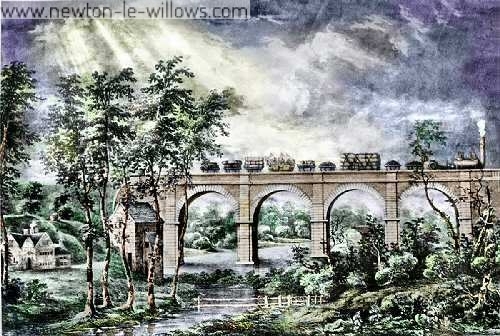
WoodPrint of Newton Hall coloured by Steven Dowd
Shows Newton Hall on left side with Newton Mill central, both besides Newton Bridge
It is not certain how long Newton Hall remained in the ownership of the Blackburns. Cole states that Thomas inherited the property from his father and later left to go and resided at a place called Orford. (25) He does not give a date for this. He does claim that the hall and the estate were sold by John Blackburn, MP. to Sir Thomas Legh "in the early part of the last century. " (26) As Cole was writing during the early part of the 20th century he obviously means that the sale took place early in the 19th century. It would appear that he is mistaken here. As will be seen later, there is documentary evidence to show that the Legh s were in possession of the hall by the 1660s.
(20) Ibid p.177
(21) Ibid p.177 and Lane, History, p.53
(22) Lane, History, pp. 52/3
(23) Cole, Newton, p.177
(24) Lane, History, p. 53.
(25) Cole, Newton, p.177
(26) Ibid p.177
There is evidence to suggest that prior to the Legh s gaining ownership, Newton Hall was owned by Sir Richard Fleetwood The Fleetwood certainly held the Barony, Manor, and Borough of Newton along with a number of lands and buildings. They inherited sometime during the mid to late 16th century through a female line of the Langtons (27) What is not certain is if Newton Hall itself formed part of the Manor or Barony. Cole claims that it did not. (28) However, other evidence appears to show, or at least indicate, that the hall did form part of the Manor. Firstly, references to the hall as the Manor House would suggest that it was attached to the Manor. (29) An Indenture in the Legh archives states that the hall was part of the Manor.
"All and every the manner Borrough and Barony of Newton in Makerfield with the Rights and Royalties members and appurtenences thereof in the aforesaid County of Lancaster And all those the capital/ messuage or Mannor house of or in Newton in Makerfield in the said County of Lancaster now or heretofore called or known by the name of Newton hall or the hall of Newton with rights members and appurtenences thereof and All and every the demesnes and demesnes Lands of or in Newton in makerfield aforesaid (30)
(27)Riley, Newton in Makerfield p.8
(28) Ibid, p 178
(29) MCC Arch. Rep.
(30) Legh of Lyme Muniments, Box A no. 20
This document clearly indicates that Newton Hall formed part of the Manorial estate. Further credence to this theory is given by Philpott who actually mentions that demesne lands were attached to Newton HalL (31) Indeed, 2 sources cite Sir Richard Fleetwood as being the owner of both Newton Hall and the Mill, although they both give differing dates when referring to the same event. The M.C.C. Archaeological report states that in 1653 " …. Newton Hall and mill, then the property of Sir Richard Fleetwood, were broken into and damaged. " (32) Phillpot gives the date of this break in as 1655. (33) Regardless of the exact date of the break in at Newton Hall, this evidence clearly indicates that the Fleetwoods, who were Lords of the Manor, did own Newton Hall, and together with the information given in the above Indenture, it does seem to show that Newton Hall was included as part and parcel of the Manor.
(31) Philpott, Historic Towns, p.56
(32) MCC. Arch. Rep. P.23.
(33) Philpott, Historic Towns, p.18
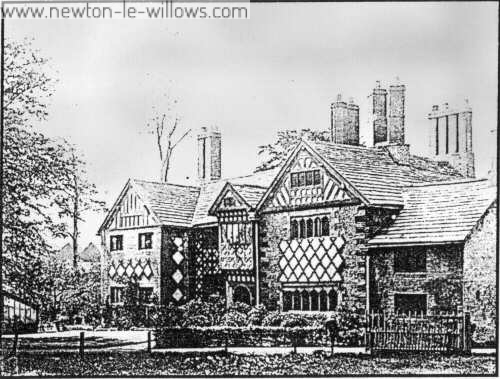
Newton Hall, Newton-le-Willows, front view
In 1651, following the Civil War conflict between King Charles I and Parliament, Sir Richard and Sir Thomas Fleetwood had their lands and estates sequestrated for being both supporters of the Kings cause and Roman Catholics;
"… and in the accounts exhibited by the Commissioners for the said County, November 12th 1651, the desmene of Newton and Newton Park are mentioned to be under sequestration for the delinquency and recusancy (34) of Sir Richard Fleetwood, and in their accounts exhibited 13, June 1652, two thirds of his tenement rents in Leyland Hundred, and of his lands in Newton Park, are mentioned as being sequestrated for the recusancy of Sir Thomas Fleetwood [his son]. " (35)
However, some of the Fleetwoods lands and property, were at the time in the possession of a creditor, one William Osbourne, a Salter from London. (36) Osbourne appears to have sided with the Parliament during the conflict as sometime before June 1652, he had ejected Sir Thomas Fleetwood from his residence, the Mansion House of Newton." (37)
(34) Delinquency or Delinquent was the term given by the Parliament and its supporters to all those who followed and gave support to the Kings cause. Recusant is a Roman Catholic or other who refuses to attend Anglican services.
(35) Scanning, J. H., (Ed), The Royalist Composition Papers Vol H C-F, The Record Society for Lancashire and Cheshire, 1892, p.343. (henceforth, Scanning Composition Papers.)
(36) Ibid, p.342.
(37) Ibid p.343.
If, as it would seem, the Fleetwoods held the manor of Newton, this would suggest that the Mansion house and the Manor House were one and the same — Newton Hall. The fact that Newton Hall was broken into in either 1653 or 1655, suggests that the property was unoccupied at the time and further suggesting therefore, that Newton Hall was infact the Mansion House whose occupant had been evicted during 1652 or before. Indeed, the Royalist Composition Papers cite a petition from Sir Thomas Fleetwood, dated 22 December 1652, relating to his property that was currently in the hands of his creditor, Osborne. He claimed that Osborne .’ was suffering the buildings to go to decay, and impoverishing the land, to the prejudice of the Comonwealth and petr. … (38)
Considering all this evidence together, it would seem that Newton Hall and Thomas Fleetwoods Mansion House were one and the same. Also, as the Fleetwood s were the Lords of the Manor of Newton it would suggest that Newton Hall was part and parcel of Manor.
However, Cole refutes this. He claims that in about 1652, when Sir Thomas Fleetwood was ejected from his Mansion House, the Blackburns were still in residence at Newton Hall. (39) The Mansion House, he believed, was a property later known as the Parsonage House and cites an earlier historian called Beaumont who was of the same belief (40) Also, referring to Dr. Kuerden s visit to Newton in 1695, he states that Newton Hall and the lands adjoining did not at that time belong to the Lords of the Manor. His theory behind this thinking is his conviction that Newton Hall was not purchased by the Legh s until 1829. (41) However, he does concede regarding Newton Hall and its adjacent lands;
. . . if they ever did so at an earlier date [belong to the manor], and presumably the baronial residence , or the site of it, would pass the Legh s when they purchased the barony in 1600. (42)
(38) Ibid p.340.
(39) Cole, Newton, p 78.
(40) Ibid p.178.
(41) Ibid p.178
(42) Ibid p.178
As Cole acknowledges, the Manor and Barony was purchased by the Legh s in 1660 and the earlier mentioned Indenture clearly shows that Newton Hall was in the possession of the Legh s by 1665. This fact, combined with the lack of any other evidence to show that Newton hall was purchased by the Legh s in 1829, appears to indicate that Newton Hall did indeed form part of the manor.
However, if this is this case, and the evidence appears to show that it is, it leaves one question unanswered — If Newton Hall formed part and parcel of the manor. i.e. as has been shown, it passed from the Banastres, to the Langton s, the Fleetwoods and then the Leghs, how did the Blackburns come to build and reside in the property when their ownership coincided with the Fleetwood s being the Lords of the Manor? Philpott claims that Richard Blackburn was Lord of the Manor when he built Newton Hall in 1634. (43) This, if it were true, would answer the question. However, no other evidence could be found to support this and evidence relating to the Lordship of the Manor at the period all suggests that the Fleetwoods were indeed the Lords of the Manor at that time. Lane does state that the Blackburn s purchased an estate from the Langton s, who, were Lords of the Manor before the Fleetwoods. (44) He does not say if they purchased the estate outright of if it was just leased. In either case, it could have reverted back to the Manor either at the end of the lease or by purchase. As there is no evidence to support either theory, it must be treated as pure conjecture, but it does explain how the property appears to have been in the hands of the Blackburns, when, if it did indeed belong to the manor, the manor was held by the Fleetwoods.
(43) Philpott, Historic Towns, p. 18.
(44) Lane, History, p.51
Newton Hall and The Leghs
In 1660 the Legh family from Cheshire, one time owners of Lyme Park, purchased the Manor and Barony of Newton from the Fleetwood s. (45)
"On the 31 (46) October, 1660, Sir Thomas Fleetwood, and Richard Fleetwood, Esquire, his son and heir apparent, sold the manor, borough, and barony of Newton and the Fee of makerfield, and the capital messuage or manor house of Newton-in-Makerfield, with all the messuages, lands and hereditaments there, which are described at great length, the Richard Legh, Esquire, his heirs and assigns, in consideration of the sum of £3,500; and the barony then passed out of the Fleetwood family name.
Presumably, the `capital messuage or manor house refers to Newton Hall. Indeed the aforementioned indenture, dated 1665, certainly names Newton Hall as the capital messauge.
"And all those capital messuage of mannor house of or in Newton in Makerfield, in the said county of Lancaster now or heretofore called or known by the name of Newton hall or the Hall of Newton " (47)
This indenture, dated 17th July 1665, is quite lengthy and for the most part describes how lands mentioned in the document have come into the ownership of Richard Legh. The document itself relates to the sale of The Manor, Borough and Barony of Newton in Makerfield, including the manor house, Newton Hall, along with other manors in Legh s possession. These Manors and Boroughs and Baronys were sold to Sir Robert Cotton, Sir Peter Brooke, Thomas Chirchley, the elder, Thomas Cholmondley and Hugh Dicconson for the sum of 5 shillings. A rather meager amount even in 1665. Furthermore, they were to pay a rent of 6.d. It appears that this transfer of ownership was only for a period of 6 months. (48)
(45) Ibid, p.4 and Riley, Newton in Makerfield, p.8.
(46) Cole, Newton, p. 94.
(47) Legh of Lyme Muniments, Box a No. 20.
(48) ibid.
The Hearth Tax Returns of the late 17th century for Newton in Makerfield do not mention Newton Hall by name. Indeed, the names of properties are not recorded, merely the names of the owner and or occupier. The records for Newton do not give the name of anyone who is known to be associated with Newton Hall therefore it cannot be said who was occupying the property then. It was certainly in the ownership of the Legh s, but as their name does not appear as the occupier, it must be assumed that a tenant was living at the hall.
Very little evidence relating to Newton Hall during the 18th century was found, although it was still in the ownership of the Legh s. A number of estate records, such as lists of tenants and rent books were found in the Legh Muniments at the John Rylands Library in Manchester, but they yielded little information. These documents either just referred to the tenant by name or the property as messuages, tenaments, or cottages, not giving any actual names. As such it made identifying an individual property difficult. No names were found of people who are known to have been associated with the Hall. However, one such document clues mention Newton Hall. This document dates from some time after 1721 and says;
"The scite(?) of the Manor House called Newton Hall with the lands and appurtenances thereunto belonging now in my portion. " (49)
(49) Legh of Lyme Muniments, Old register: List of tenants of Peter Legh, Box P, A, No. 1.
This clearly shows that Newton Hall was still in the possession of the Legh s and as it is mentioned specifically in this documents it would suggest that the Legh s were using it for their own purpose, and not renting it to a tenant.
Newton Hall in the Nineteenth Century
By 1825, Newton Hall, still owned by the Legh s, was occupied by Thomas Boardman and was run as a farm. (50) Baines does give Boardman s address as the Old Hall, but other evidence shows that this is clearly Newton Hall. Baines goes on to describe the Old Hall;
"There are several very ancient houses in the township. The Old Hall and the Oak Tree House, both built of wood, and situated at opposite extremities of the Borough, are worthy of notice. Adjoining the Old Hall is a small rising ground, formerly surrounded by a moat, and tradition represents that it was a royal residence." (51)
The mound would seemingly refer to the site of the 11th / 13th century structure and the Langton s 14th century crenellated manor. However, his claim that tradition has it that was once a Royal residence is somewhat suspect.! Another source, Arthur Mee, writes of a farm house, called the Old Hall, and describes it as having the Arms of Elizabeth I over a fireplace. (52) As will be seen later, Newton Hall did sport such a feature.
(50) Baines, E, History, Directory and Gazetter of the County Palatine of Lancashire, VoL II, 1925. P.435. (henceforth ` Baines, Lancashire)
(51) Ibid, p.434.
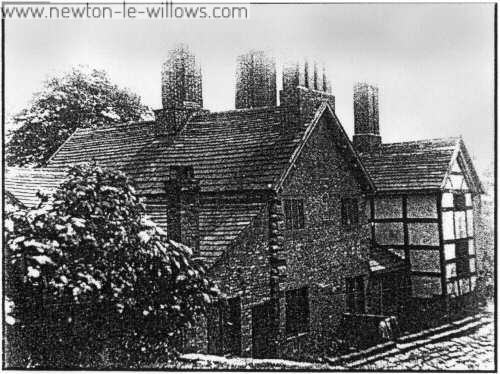
Newton Hall, Newton-le-Willows, rear view
Other evidence of Newton Hall and the Old Hall being one and the same comes from the Tithe Map of 1839. Newton Hall is named on the tithe map along with its adjoining fields. (53) The owner of the land, was given as Thomas Legh and the tenant as Thomas Boardman. The plot containing the actual Property of Newton Hall has not got an owner or occupier ascribed to it, probably because it was a classed as residential and not providing any produce, thus not subject to paying any tithe. However, as all the surrounding land was owned and occupied by Thomas Legh and Thomas Boardman respectively, it can be assumed that the same could be said of the hall itself. Further evidence of Boardman s occupation at Newton Hall is derived from Rileys edited version of Lanes history of the town;
. .Edwards Ball, the father of the Edward Ball who followed Thomas Boardman at Newton Hall. (54)
Both Thomas Boardman and Edward Ball appear on the Census Returns for Newton. In 1841 Newton Hall is not mentioned on the Census Returns, but Thomas Boardmans address is given as Mill Lane. As his occupation is described as a `Farmer it reasonable to assume that this is indeed the Thomas Boardman in question and that the address in Mill Lane refers to Newton Hall. Six other people are given as residing at the same address. Four of these would appear to be Boardman s sons as they have the same surname, but there are also 3 women mentioned who have different surnames. They are probably domestic servants or possibly relatives. (55)
(52) Mee, Arthur, The Kings England; Lancashire, 1973, p. 148
(53) LRO, Tithe Map, DRL1/56,1839.
Ten years later the Boardman s had left Newton Hall and it was now occupied by the Clayton family who farmed 111 acres and employed 4 in labourers and 2 out labourers. (56) With William Clayton, aged 59, were his wife, Ellen, aged 53 and one daughter, also Ellen, aged 15. They had two domestic servants, 19 year old Ann Boardman, and Alice Clayton, 57 years old. Alice Clayton had also been in service at Newton Hall during the time that the Boardman s were there. They had
4 farm labourers who lived on the premises, Peter Boardman, Richard Kemp, Thomas Battersby and Patrick Newell, aged 25, 60, 50 and 40 respectively. (57)
(54) Riley, Newton in Makerfield, p.48.
(55) 1841 Census Returns, Newton in Makerfield, H0107/524/14 ,enumeration district 6,
(56) 1851 Census Returns, Ref H0107/2202, enumeration district 2c, ff. 120/120A
Edward Ball and his family were installed at Newton Hall by 1861.(58) The size of the farm had now grown to 150 acres. Also living there were Edwards we, Margaret, who, at 72, was 4 years older than her husband. Also, there was their son, John, aged 40,, and his wife, 35 year old Sarah, together with their son and Edwards grandson, John, 18 years old. They employed two live-in agricultural servants, 32 year old James Newton and 52 year old James Gain(?). The only domestic servant was Martha Murray, a 54 year old widow. (59)
(57) Ibid
(58) 1861 Census Returns, ref; RG9/2787, Enumeration district 1, ff. 27.
(59) Ibid
The Balls were still at Newton Hall in 1871, but by now Edwards son, John, had taken over the running of the farm. (60) His wife, Sarah, was still alive and with them lived six of their children, Annie, Walter, Clara, Manley John, Emily and Rowland They were aged 9, 8, 7, 5, 3 and 1 respectively. Johns neice, Lucy, was also living with them. She is described as being a domestic servant but it is not clear if she was working in this capacity for the Balls or if she was employed elsewhere. (61)
John Ball was still farming Newton Hall in 1881, but by now he was 61 years old and his wife, Sarah, had died. (62) Johns daughter, Annie, was no longer living at the family home, but six of his other children were, Walter, Clara, Manley J. Emily, Rowland and Douglas. Douglas had been born since the 1871 Census and he was 9 years old. Also living at Newton Hall was James ONeil, a 23 year old Farm Labourer. (63)
(60) 1871 Census Returns, RG/3899, enumration district 1, ff 30.
(61) Ibid
(62) 1881 Census Returns, RG11/3787, enumeration district 5, ff 66.
(63) Ibid
The Balls had moved on by 1891 and Newton Hall was occupied by the Wrights. (64) The head of the household was Robert Hood Wright, 44 years old His wife was 46 year old Hannah and they had one child, Robert Hood, who was 10 years old Also living with them was Robert s nephew, Clarence Hutton Wright, a 19 year old apprentice Mechanic. They employed two house domestic servants and two Agricultural labourers. Annie Malloy, 29 and Eleanor Fenner, 23, were the Cook and Housemaid respectively, whilst William Dowd, 20, and Thomas McCann, 50, were the agricultural labourers. (65)
Whilst Robert Hood Wright was at Newton Hall, sometime between 1881 and 1913, he embarked upon a re-building programme details of which will be covered later. (66) However, according to Lane, care was taken to preserve the outward appearance of the front of the hall, ". (67)
(64) 1891 Census Returns, RG12/3070, enumeration district 5, ff. 64.
(65) Ibid
(66) Lane, History, pp.51-2.
(67) Ibid, p.52
The Wrights had left Newton Hall by 1913. At this date the occupant was Peter Boydell, a farmer, and the property was being known as Newton Hall Farm. (68) At some point during the Boydell s occupation of the hall it became known as Boydell s Farm. (69)
(68) Kellys Directory of Lancashire, 1913, Kellys Directories Ltd, London, 1913.
(69) Fairhurst, W., `Looking Back, in Vulcan Magazine, no date (probably mid 20th C.
It is not certain who actually owned the Newton Hall from the mid 19th century onwards. Certainly in and around 1840 when the Boardman s were in residence it was still owned by the Legh s, as the Tithe records show. No evidence could be found after this date to show if the Leghs still owned the property and land or not. However, it would appear that the occupiers were in fact only tenants and not owners.
The MCC Archaeological Report cites another source, dated 1909, which claims that the hall was " . . .restored about thirty years ago, by the owner, Lord Newton." (70) This, presumably, refers to the alterations that were done during the occupancy of the Wrights sometime after 1881. The same source also states "The name `Newton Hall confirmed by tenant" and gives a date of 1939 for this statement. (71) Clearly the occupier was not the owner. Unfortunately the report does not give the name of the owner at this time, merely that in 1909 it was Lord Newton.
(70) MCC. Arch. Rep.
(71) Ibid
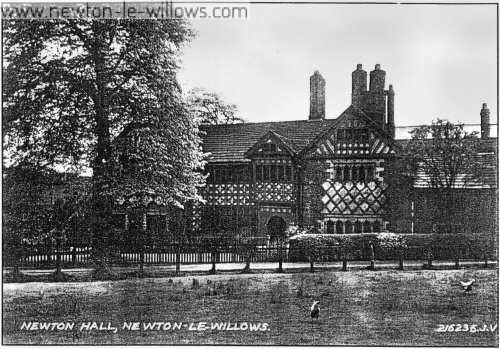
Newton Hall, Newton-le-Willows, front view
1939 saw the outbreak of the Second World War. An examination of the list of requisitioned Premises for Newton-le-Willows did not find any mention of Newton Hall having been requisitioned for a purpose. However, this is not entirely surprising. As Newton Hall was a farm, it would no doubt have continued to operate as such, supplying much needed supplies for the food market.
Quite when Newton Hall ceased to be occupied is not known, but it must have been some time before or during the early 1960s as by the middle of that decade the property was derelict and the prey of vandals. It was sadly demolished in 1965.
Description
Newton Hall stood north to south on its site and it is claimed by Lane that it had a moat. (72) However, this is not substantiated as it seems that this moat, if it did exist, was part of the earlier property on the site. Philpott supports this view. (73) A brook runs close to the hall, and this could have been mistaken for the moat. Lane claims that the moat has merged with the brook. (74) Lane goes on to say that there was a plateau behind the house, several feet above the ground floor, and describes it as being a mound. He also claims that the mound contained subterranean passages and walls. This mound was apparently incorporated into the railway embankment when the railway was built. (75) It is possible that this mound was the site of the earlier property.
(72) Lane, History, p.52.
(73) Philpott, Historic Towns, p. 18.
(74) Lane, History, p. 52.,
(75) Ibid
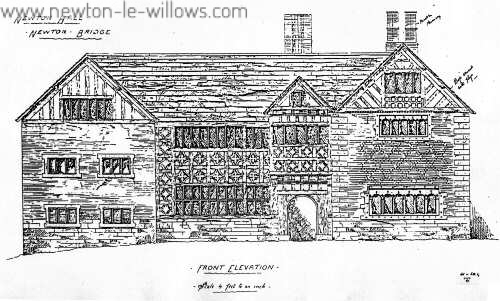
Scale drawing of Front Elevation
The hall was `H shaped with two projecting gables, one at either end and a porch in the middle. (76) The foundations were of solid brick work and the corners stone. (77) The upper part of the building was timber and plaster. (78) Both Lane and Cole say that this was painted black and white. (79) However, this was probably done during the 19th century, possibly at the time of Mr. Wrights renovations. The practice of painting timber framed properties in black and white was a Victorian idea. The original colouring would have been somewhat different. The timber would have been its natural colour which no doubt would have darkened through age and weathering. The same would have applied to the plaster panels between the timber frames. These would have been a cream / ochre colour.
(76) Ibid, Cole, Newton, p.177, Philpott, Historic Towns, p, 18 and MCC. Arch. Rep.
(77) Cole, Newton, p,177 and Lane, History, p.51.
(78) Ibid
The windows of the hall were mullioned and ran in long rows along each storey. The windows in the great hall contained stained glass and the family coat of arms. (80) The great hall itself was situated in the middle of the property between the two projecting gables. A staircase rose from this hall to a gallery which ran around the great hall. This feature is characteristic of many properties dating from this period The upper rooms were entered from this gallery. (81)
(79) Lane, History, p.51.
(80) Ibid p. 52 and Cole, Newton, p. 177.
(81) Ibid
At the north end of the great hall was a fireplace decorated with a coat of arms. All accounts claim that this coat arms was that of Queen Elizabeth I. However, it is perhaps strange that a property built during the reign of King Charles I should have the arms of the last but one monarch incorporated into it. (82) The coat of arms in question is certainly a Royal coat of arms, but without specialist knowledge relating to heraldry it cannot be said for certain whether or not it is the arms of Queen Elizabeth I.
(82) Queen Elizabeth 1 reigned until 1603. She was succeeded by James 1, 1603-1625. Following his death, his son, King Charles I reigned 1625-1649.
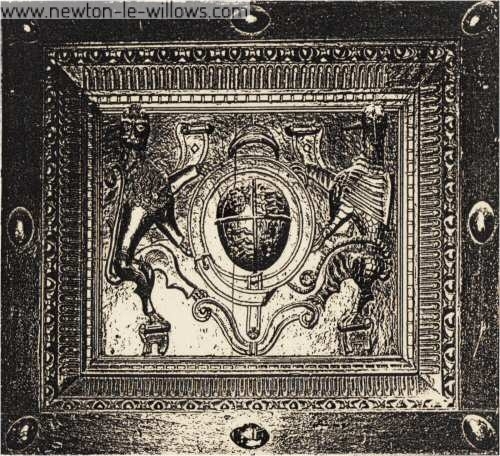
A long Oak table is recorded as standing in the great hall. Either side of the central, great hall are the other domestic rooms. One side are the living rooms and on the other the kitchens. (83)
Extensive renovation work was carried out to the hall during the latter part of the 19th century when the hall was occupied by the Wrights. It is not certain who actually undertook, or was responsible for, the renovations, Robert Hood Wright, the tenant, or Lord Newton, the owner. (85) However, regardless of who was responsible, considerable work was done.
(83) Philpott, Historic Towns, p.18
(84) Lane, History, p.51
(85) Ibid and MCC Arch Rep.
Internally, the gallery disappeared. It was incorporated into the rooms on the upper storey, thus, presumably making them larger. The fireplace was rebuilt. It had originally been built of brick but these were replaced by stone. (86)
Lane states that the external look of the property was not altered dramatically.
"On its restoration when Mr. Hood Wright came to the place, care was taken to preserve the outward appearance of the front of the hall, with the result that the raised brickwork patterns of diamonds and fleur-de-lis are retained " (87)
(86) Ibid
(87) Lane, History, pp51-2
It was probably at this date that the property was painted in the characteristic Victorian black and white.
Conclusion
As can be seen from the contents of this report, much of the material available relating to Newton Hall contains an amount of conflicting and contradictory information. However, from an analysis of this information a picture appears of the 17th hall. This picture not only details the chronological history of the property, but it also gives some information about the people who lived and worked at Newton Hall.
The builder of the property, Richard Blackburn, has his thoughts and feelings revealed at the time that the hall was built. The hall was a `victim of the Parliamentary practice of sequestrating property belonging to supporters of the King and Roman Catholics during the Civil War period During this period of sequestration, it was vandalised as a result of a break in. The 19t century sees Newton Hall operating as a farm and the Census Returns give extensive details relating to the people who lived and worked there.
From this information a vivid picture can be created about Newton Hall and its owners and residents and the lives that they lead and the times that they lived in. Actual photographs and drawings of the building, together with graphic written descriptions of the interior of the property all serve to enhance this picture.
All these details serve to put flesh onto the bones of the basic historical facts and bring Newton Hall, sadly demolished over 35 years ago, back to life.
Bibliography Primary Sources
List of Illustrations (In the order that they appear)
Sketch of Newton Hall, by R. J. K. Cahill
Sketch of Newton Hall by R A. Collings.
Newton Hall, Newton-le-Willows, front view (photograph)
Newton Hall and Newton Hall, rear view (photograph)
Newton Hall, Newton-le-Willows, front view (photograph)
Scale drawing of Front Elevation – 4 feet to one inch scale. (From Merseyside County Council Archaeological Report.)
Coat of Arms – believed to be those of Queen Elizabeth I (photograph)
Manuscript
John Rylands University Library. Manchester
Legh of Lyme Muniments; Indenture; 17th July 1665, Box A., No. 20
Old Register; List of Tenants of Peter Legh, Box P, No. 1.
Lancashire County Records Office
DRL1/56; Tithe map, Newton-in Makerfield,1839
Census Returns; 1841 — Newton-in Makerfield, HO107/524/14
Enumeration District 6
1851 — Newton-in-Makerfield, H0107/2202,
Enumeration District 2c, ff 120/120a 1861— Newton-in Makerfield, RG9/2787,
Enumeration District 1, ff 27 1871 — Newton-in Makerfield, RG10/3899,
Enumeration District 1, if 30 Hearth Tax Returns, 1662 — El 79/250/6, West Derby Hundred
LCC: Requisitioned Premises, 1936-45
St. Helen s Library and Local Studies Unit.
Census Returns; 1881 — Newton-in Makerfield, RG11/3787,
Enumeration District 5, f66 1891 – Newton-in Newton-in Make>feld, RG12/3070,
Enumeration District 5, f64
Published
Kellys Directory of Lancashire, 1913,
Kellys Directories Ltd., London, 1913. Stanning, J. H., (Ed.),
The Royalist Composition Papers, VoL II C-F,
The Record Society for Lancashire and Cheshire, 1892.
Secondary Sources
Baines, E, History, Directory and Gazeteer of the County Palatine of Lancashire, VoL II, W. M Wales and Co., 1825.
Cole, C., A History of Newton-in-Makerfield, 1916.
Lane, John, Henry, Newton-in-Makerfield; Its History, VoL I, 1914.
Mee, Arthur, The Kings England; Lancashire, Hodder and Stoughton, 1973.
Newton-le-Willows, Newton Hall, and Newton Mill; Archaeological Report, Merseyside County Council, 1988.
Philpott, R. A., Historic Towns of the Merseyside Area;
National Museums and Galleries on Merseyside Occasional Papers, No. 3., Liverpool Museum, 1988.
Riley, Peter, (Ed.), Lane, J. H., A History of Newton-in-Makerfield, P. & D. Riley, Warrington, 1992.
Fairhurst, W, `Looking Back, Vulcan Magazine, No date. (probably mid 20th C)
Special thanks for the use of the text in this posting must go to one of the website visitors “Marjorie”, who describes herself to me as a “Lancastrian in London”.
Marjorie informed me that she was brought up In Newton close to Newton Hall, and that some years ago she commissioned a history on both Newton Hall and Dean School, some months back Marjorie posted to me the photo-copied pages concerning Newton Hall and Dean School for my use in the website, which now I have transcribed are here for you in full, with a few added photos.
please take note that since I am typing all this, and I can niether spell or type well, some errors and ommisions in the history, are to be expected.
Steven Dowd

